The X Chromosome inheritance patterns are complex but when the planning is right and your relatives indulge your curiousity about their DNA then the resulting X DNA matches seem serendipitous.
My brother wisely counselled establishing a sound foundation upon which to build my genetic genealogy research. My cousin Val started me off by agreeing to indulge my curiousity and undergo a DNA test.
My curiousity at that time concerned the origins of George Watts’s wife Mary McCade or McCord who was born about 1800 in Foreign Parts.
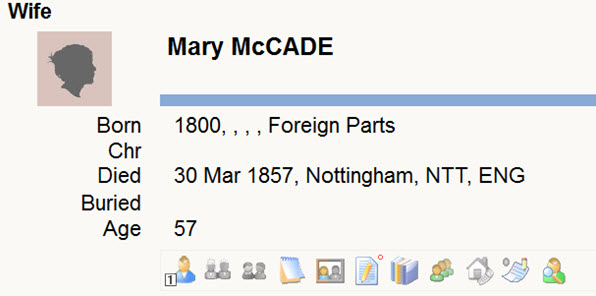
If you are a descendant please read on. If you believe you may have inherited some of your X DNA from George’s family or, in particular, from his wife I would love to hear from you.
Even if you aren’t a member of this family do read on.
I have been putting off my analysis of Lyn and Val’s X chromosome matches even though their DNA test results were the first DNA test results I received. My procrastination is entirely because of the inheritance patterns of the X chromosome. Of course, its complexity is no reason to ignore significant X DNA matches. So the purpose of this post is to look at some X DNA match results I have received. Even if I take the low road to get there.
Before I delve into the mysteries of X DNA let me just go back to the beginning of analysing our DNA matches. DNA for family history purposes isn’t just one analysis process but four:
. analysis of matches on the X chromosome
. analysis of matches on the Y chromosome
. analysis of matches on the 22 autosomal chromosomes and
. analysis of matches for mitochondrial DNA.
Let me set the scene for analysing X DNA matches by beginning with a short review of the analysis of other DNA matches.
The most common analysis has been of the Y Chromosome. It’s relative simple to identify which ancestor provided a male’s Y DNA. A male receives his Y DNA from his father. In turn, his father receives his Y DNA from his father. And so on up the paternal line (following the family surname).
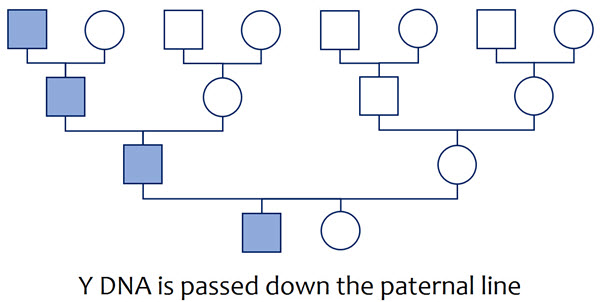 Identifying which ancestor provided our mitochondrial DNA (mtDNA) follows a similar process. With a slight change. All children, whether male or female, receive their mtDNA from their mother. I received my mtDNA from my mother. As did my brother. In turn our mother received her mtDNA from her mother. And so on up the maternal line (with, in my family at least, the surname changing each generation).
Identifying which ancestor provided our mitochondrial DNA (mtDNA) follows a similar process. With a slight change. All children, whether male or female, receive their mtDNA from their mother. I received my mtDNA from my mother. As did my brother. In turn our mother received her mtDNA from her mother. And so on up the maternal line (with, in my family at least, the surname changing each generation).
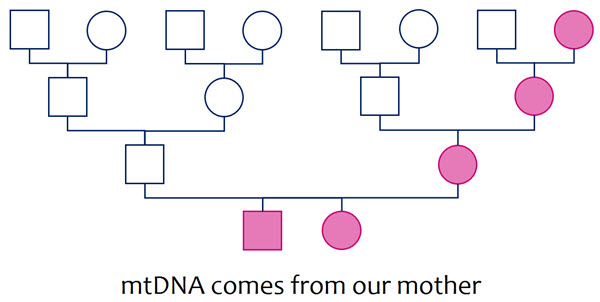 There are no half way measures with Y DNA and mtDNA. My brother received all of our paternal great grandfather’s Y DNA and we each received the same mtDNA from our maternal great grandmother.
There are no half way measures with Y DNA and mtDNA. My brother received all of our paternal great grandfather’s Y DNA and we each received the same mtDNA from our maternal great grandmother.
Autosomal DNA (atDNA) is a little different. It is more difficult to determine which ancestor we received our atDNA from. Suffice to say, on average, we receive half our atDNA from our father and half from our mother. My father received half his atDNA from his father and half from his mother. Similarly, my mother received half her atDNA from her father and half from her mother. This means I received half my atDNA from each of my two parents, a quarter from each of my four grandparents, and one eighth from my eight great grandparents and so on up my family tree.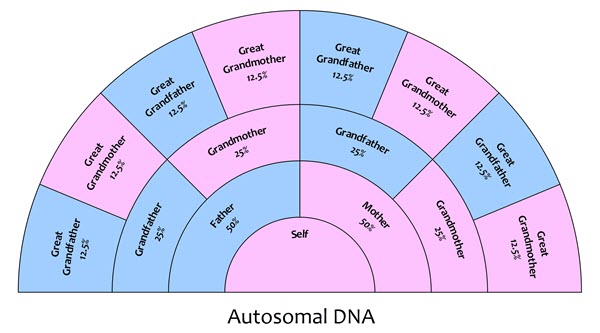 These amounts aren’t set in stone however. They are not precise. It’s only probable that I received precisely half my atDNA from my father and precisely half from my mother.
These amounts aren’t set in stone however. They are not precise. It’s only probable that I received precisely half my atDNA from my father and precisely half from my mother.
With Y DNA and mtDNA it is clear which is received from which of our ancestors. With atDNA we can estimate how much atDNA we received from each of our ancestors but it is less clear just which DNA we received from a particular ancestor.
Now we come to the X Chromosome and its inheritance patterns.
Let’s start with myself. I received half my X DNA from my father and half my X DNA from my mother. In turn, my mother received half her X DNA from her father and half from her mother. As far as this example goes, the X DNA inheritance pattern is like the inheritance pattern for autosomal DNA.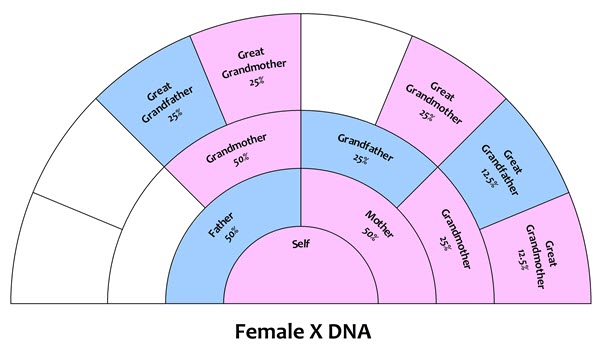 Now let’s look at my brother. My brother received no X DNA from our father because he received a Y chromosome instead. That is, he received all his X DNA from our mother. Similarly, my father received no X DNA from his father. Instead he received his Y DNA from his father and all his X DNA from his mother.
Now let’s look at my brother. My brother received no X DNA from our father because he received a Y chromosome instead. That is, he received all his X DNA from our mother. Similarly, my father received no X DNA from his father. Instead he received his Y DNA from his father and all his X DNA from his mother.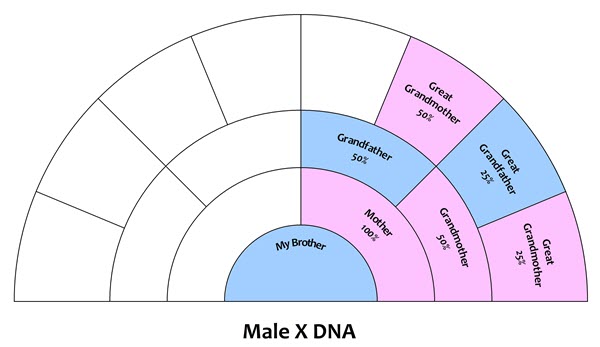 Let’s now look at a simple X DNA match before looking at a couple more complex and interesting DNA matches.
Let’s now look at a simple X DNA match before looking at a couple more complex and interesting DNA matches.
It’s expected that my brother and I match on 50% of our X DNA (with that X DNA originating from our mother). In fact, we matched on 88.5 centiMorgans (cMs) – 45% of our X DNA and a little less than estimated. Here is what our match looks like in the Family Tree DNA chromosome browser: Now let’s look at two first cousins – Lyn and Val. Their mothers were sisters and were daughters of Samuel and Eliza Ann.
Now let’s look at two first cousins – Lyn and Val. Their mothers were sisters and were daughters of Samuel and Eliza Ann.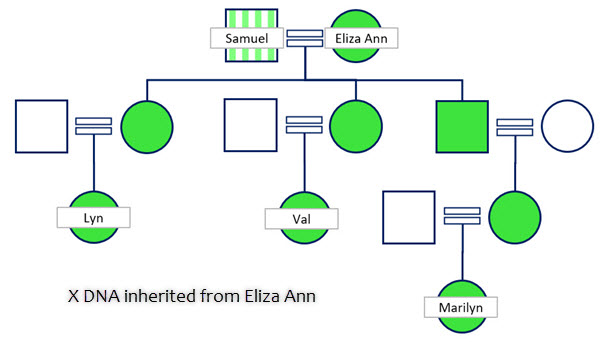 Lyn received half her X DNA from her father and half from her mother. In turn, Lyn’s mother received half her X DNA from her father, Samuel, and half from her mother, Eliza Ann. That is, Lyn received 25% of her X DNA from her grandfather Samuel and 25% from her grandmother Eliza Ann.
Lyn received half her X DNA from her father and half from her mother. In turn, Lyn’s mother received half her X DNA from her father, Samuel, and half from her mother, Eliza Ann. That is, Lyn received 25% of her X DNA from her grandfather Samuel and 25% from her grandmother Eliza Ann.
Similarly, Val received half her X DNA from her father and half from her mother. In turn, Val’s mother received half her X DNA from her father, Samuel, and half from her mother, Eliza Ann. Here is how Lyn and Val’s X DNA match of 49.4 cMs (25% of their X DNA) looks like in the Family Tree DNA chromosome browser: As expected Lyn and Val match on just over half the number of cMs that my brother and I do.
As expected Lyn and Val match on just over half the number of cMs that my brother and I do.
Samuel and Eliza Ann are my paternal great grandparents but neither my brother and I would have received any X DNA from this line as my father received a Y chromsome from my grandfather and, consequently, no X DNA from my grandfather.
Now do I have anyone else who may have received some part of their X DNA from my great grandparents Samuel and Eliza Ann? My first cousin Marilyn did. And this is where expected X DNA becomes complicated.
Marilyn received half her X DNA from her father and half from her mother. In turn, her mother received half her X DNA from our grandfather and half from our grandmother. Now our grandfather received his Y chromosome from his father, Samuel and his X chromosome from his mother Eliza Ann. The probability is that Marilyn received 25% of her X DNA from her great grandmother, Eliza Ann and none from her great grandfather Samuel.
There are two points to take note of here.
Firstly, X DNA isn’t like mtDNA. It doesn’t merely go up the female line. You can have one male in the sequence. Our grandfather in Marilyn’s sequence is one example. But you can’t have two males in the sequence and inherit X DNA from that line. My brother and I haven’t received any X DNA from our great grandparents Samuel and Eliza Ann because there are two men in the line – my father and my grandfather.
Secondly, any match that Marilyn may have on her X DNA with either Lyn or Val, must be attributable to Marilyn’s great grandmother Eliza Ann because our grandfather received no X chromosome from his father Samuel. Marilyn shares 58.3 cMs (30%) with Lyn and 72.9 cMs (38%) with Val. When I map Marilyn’s matches with Lyn and Val I see the segments of Marilyn’s X DNA that come from her great grandmother Eliza Ann.
When I map Marilyn’s matches with Lyn and Val I see the segments of Marilyn’s X DNA that come from her great grandmother Eliza Ann.

It is Lyn’s X DNA match that I find most intriguing. She has a X DNA match with:
• Val, her first cousin on her mother’s side
• Marilyn, a first cousin once removed on her mother’s side and
• Rick, her second cousin on her father’s side.
 So now let’s look at Lyn’s X DNA match with Val. Lyn received half her X DNA from her mother who received her X DNA from her parents Samuel and Eliza Ann. But I don’t know which X DNA Lyn’s mother received from her father Samuel and which she received from her mother Eliza Ann.
So now let’s look at Lyn’s X DNA match with Val. Lyn received half her X DNA from her mother who received her X DNA from her parents Samuel and Eliza Ann. But I don’t know which X DNA Lyn’s mother received from her father Samuel and which she received from her mother Eliza Ann.
The situation is the same for Val.
Consequently, where Lyn and Val match on their X chromosome I don’t know whether that match is due to X DNA they each received from their grandfather or is due to X DNA they each received from their grandmother. Further testing is required.
This is different to the scenario of Lyn’s X DNA match with Marilyn where the inheritance pattern of X DNA indicates that that match could only have come from X DNA inherited from Eliza Ann. Lyn also has an X DNA match with her second cousin Rick on her paternal side. Rick inherited all his X DNA from his mother (as he inherited his Y chromosome from his father). Rick’s mother inherited half her X DNA from her father. In turn he inherited all his X DNA from his mother Jane (as he inherited his Y chromosome from his father).
Lyn also has an X DNA match with her second cousin Rick on her paternal side. Rick inherited all his X DNA from his mother (as he inherited his Y chromosome from his father). Rick’s mother inherited half her X DNA from her father. In turn he inherited all his X DNA from his mother Jane (as he inherited his Y chromosome from his father).
Lyn inherited half her X DNA from her father. Her father inherited all his X DNA from his mother (as he inherited his Y chromosome from his father). She inherited half her X DNA from her father and half from her mother Jane.
We have another instance here of being able to determine which ancestor DNA came from. Under the inheritance pattern of the X chromosome Lyn and Rick can only match on X DNA with regards to X DNA they inherited from Jane.
Rick and Lyn have a match of 91.9 cMs (or 47%) on their X chromosome.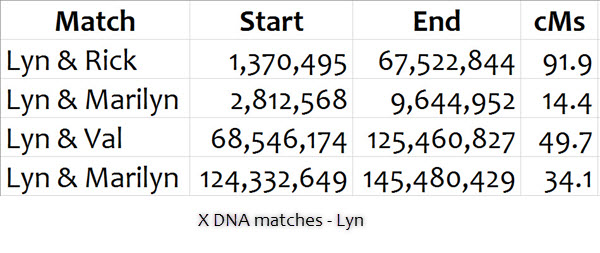 Putting Lyn’s three X DNA matches together we can see that she can attribute almost 65% to a specific ancestor (Jane or Eliza Ann) and the balance to either Samuel or Eliza Ann.
Putting Lyn’s three X DNA matches together we can see that she can attribute almost 65% to a specific ancestor (Jane or Eliza Ann) and the balance to either Samuel or Eliza Ann.
 There is further testing required to attribute her match with Val to either Samuel or to Eliza.
There is further testing required to attribute her match with Val to either Samuel or to Eliza.
For those of you who have tested in AncestryDNA and would like to explore your X chromosome all is not impossible. Download your raw data from AncestryDNA and upload it into Gedmatch for testing.
Thank you Kathy for the suggestion to use fan charts from Legacy Family Tree. They worked! These and other charts drawn in Excel were drawn by me but are strongly based on Blaine Bettinger’s trees. See, for example, his recent book Guide to DNA Testing and Genetic Genealogy by Blaine T Bettinger as well as Foundations in DNA by Blaine Bettinger: A recent series of 5 webinars found in Legacy Family Tree’s Webinar Library.
The Family Tree DNA chromosome browser examples came from our matches at Family Tree DNA , the Gedmatch chromosome map came out matches uploaded on to Gedmatch and Kitty Cooper’s chromosome map can be found on Kitty Cooper’s Blog under Tools.

2 responses to “The X Chromosome – Planning and Indulgence”
Hi Patsy. While all this about DNA is pretty much beyond me, I was lucky enough to share Christmas lunch with Lyn and Val yesterday. I wish I’d been able to show them your post.
What a nice lunch it must have been! I’ve let my enthusiasm run away with me over Lyn’s matches on her X DNA. I was so thrilled with the result. And here is why. With just three X DNA matches (Val, Marilyn and Rick) we have been able to determine that just over 90% of Lyn’s X DNA came from three ancestors – her maternal grandparents Samuel and Eliza Ann and her paternal great grandmother Jane. How good is that? I am nowhere near doing this for anyone else on either the X chromosome or autosomal DNA. Most of the DNA matches I look at are for second cousins or more remote relatives and, as a consequence, the DNA matches are merely confirming what I have found in my traditional family history research. Have a look at the relationship chart here http://blog.kittycooper.com/2015/05/new-dna-relationship-statistics-from-blaine-bettinger/ If you look at the figures in the top right hand corner of each box you will see that second cousins (2C) share about 3.125% of their DNA. So I have a lot more cousins to find before I can map where even a little bit let alone 90% of my own DNA comes from.
In the mean time I am still thinking about Auntie Kit’s claim that she was born on Squattleseamere. Certainly at the time Samuel and Eliza Ann indicated they were living on Glengleeson (or Snakey Creek) next door to Squattleseamere. Is there more to her story than the fact that Squattlseamere has more romance attached to it thank Snakey Creek? I think so but I have several years worth of titles to look at. Which I shall do as part of my own connection to Squattlseamere as well as give my view about land selection in the area.